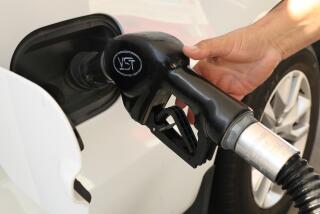Looking close to home for fuel relief
- Share via
I filled my tank at a gas station in Santa Monica last week and the price was $4.09 for a gallon of regular. Ouch.
I drove past that same station over the holiday weekend, and the price was $4.19.
Good.
Well, not good exactly. With food prices soaring and healthcare costs showing no mercy, it’s no help to working families for gas prices to be jumping 10 cents a gallon in a matter of days.
The Energy Department reported Tuesday that the nationwide average for self-serve regular gas hit $3.937 on Monday, up 14.6 cents from the week before. In California, the average climbed 14.7 cents to $4.099. Diesel is even higher, topping $5 a gallon statewide.
But the more painful that things become at the pump, the more our political and business leaders will finally realize that they need to take steps, and soon, to wean us from our self-defeating oil jones.
I’m not just talking about promoting conservation and offering incentives for people to buy hybrids and stuff like that. I’m talking about some radical thinking that could finally ease the epic commutes that are wasting so much time and fuel.
“Studies show that you only need to take 5% of cars off the road to make a difference,” said Sarah Catz, director of UC Irvine’s Center for Urban Infrastructure. “I remember the 1984 Olympics. I could just sail down the 405.”
These days, it’s an Olympic event simply getting to work.
American drivers spent 4.2 billion hours stuck in traffic in 2005, according to a recent report from the Texas Transportation Institute. That’s about 38 hours per driver, or nearly an entire workweek.
The institute estimates that all this congestion resulted in 2.9 billion gallons of wasted fuel, or about 26 gallons per driver. Factor in lost productivity, and you have an economic hit to the nation of more than $78 billion.
Not surprisingly, the Los Angeles metro area took the booby prize for worst commute, with drivers languishing an average of 72 hours a year in traffic jams -- whole days of your life that you’ll never get back.
Similarly soul-crushing commutes can be found in the San Francisco Bay Area, Atlanta, Washington and Dallas.
One answer, of course, is public transportation. But that seems to be one of those things that most of us support in the abstract but don’t make use of on a regular (or even semi-regular) basis.
I’m no exception. I rationalize my commitment to my car by telling myself that if we just had a comprehensive subway system like in New York or London or Tokyo, I’d be more than happy to leave my wheels at home.
But we don’t, so I don’t.
With the economy on the skids and state and local officials struggling to balance their budgets, I’m not holding my breath that we’ll see a vast, multibillion-dollar expansion of public transportation.
Nor do I think that Detroit will make more than a token effort at developing more fuel-efficient technologies that would significantly improve mileage. Big automakers will have to be dragged screaming and kicking into the future.
The only realistic answer I see to runaway fuel costs is to get us off the road more quickly. And that means cutting our commutes.
Let’s take advantage of what we have (a rapidly growing broadband data network) rather than waiting for what we don’t (a world-class, totally convenient public transportation system and cars that get 75 miles per gallon).
First, we need to accept that a lot of work no longer has to be done at work. Thanks to the Internet, BlackBerrys and other info-tech advances, many people can be just as productive at home as they can at the office, and sometimes even more so.
I’m not saying that we should all go off-leash. But I am saying that employers could trust workers enough to experiment with one remote day a week -- work-at-home Wednesday, for instance.
I now spend about $45 a week filling my tank, and I use my car almost exclusively for work. Staying at home one day a week would save me about $9, or $468 a year. In a sense, that’s a $468 annual raise my employer could give me without having to reach into its pockets. Talk about a win-win.
Meanwhile, local governments could give businesses tax breaks or credits to establish branch offices. Sure, you’d still have to get to the head office from time to time. But why should someone who lives on the Westside or in the Valley have to commute to downtown L.A. every day?
Let’s say that any company with more than 1,000 employees would be eligible for a tax incentive if it opened branch offices that reduced people’s commutes to 10 miles or less.
Additional tax breaks could be offered for setting up videoconferencing facilities to eliminate the need for you-are-there meetings.
“This is all very feasible,” said UC Irvine’s Catz. “All we need to do is get the public and private sectors working together.”
Or we could just keep waiting for that world-class subway to materialize. Your call.
--
Consumer Confidential runs Wednesdays and Sundays. Send your tips or feedback to david.lazarus@latimes.com.



